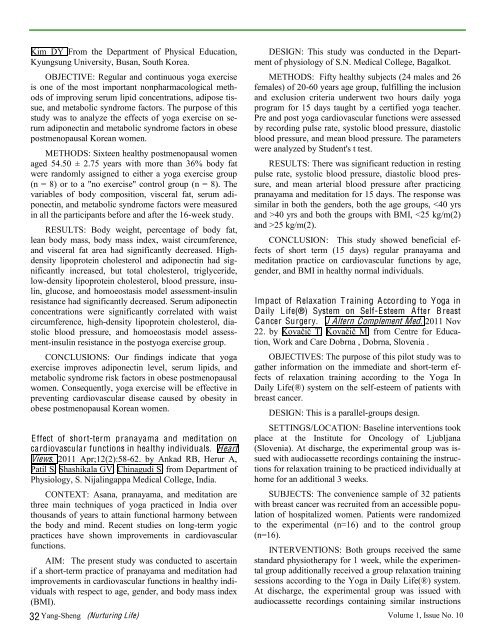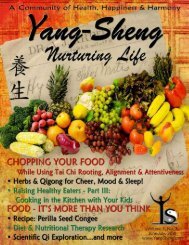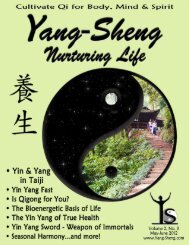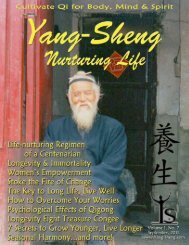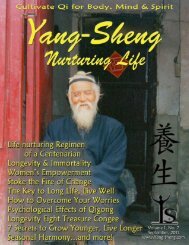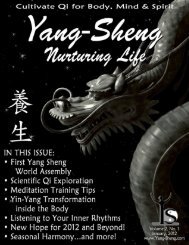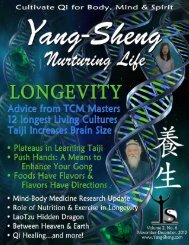Download the December issue of Yang-Sheng as
Download the December issue of Yang-Sheng as
Download the December issue of Yang-Sheng as
You also want an ePaper? Increase the reach of your titles
YUMPU automatically turns print PDFs into web optimized ePapers that Google loves.
Kim DY From <strong>the</strong> Department <strong>of</strong> Physical Education,<br />
Kyungsung University, Busan, South Korea.<br />
OBJECTIVE: Regular and continuous yoga exercise<br />
is one <strong>of</strong> <strong>the</strong> most important nonpharmacological methods<br />
<strong>of</strong> improving serum lipid concentrations, adipose t<strong>issue</strong>,<br />
and metabolic syndrome factors. The purpose <strong>of</strong> this<br />
study w<strong>as</strong> to analyze <strong>the</strong> effects <strong>of</strong> yoga exercise on serum<br />
adiponectin and metabolic syndrome factors in obese<br />
postmenopausal Korean women.<br />
METHODS: Sixteen healthy postmenopausal women<br />
aged 54.50 ± 2.75 years with more than 36% body fat<br />
were randomly <strong>as</strong>signed to ei<strong>the</strong>r a yoga exercise group<br />
(n = 8) or to a "no exercise" control group (n = 8). The<br />
variables <strong>of</strong> body composition, visceral fat, serum adiponectin,<br />
and metabolic syndrome factors were me<strong>as</strong>ured<br />
in all <strong>the</strong> participants before and after <strong>the</strong> 16-week study.<br />
RESULTS: Body weight, percentage <strong>of</strong> body fat,<br />
lean body m<strong>as</strong>s, body m<strong>as</strong>s index, waist circumference,<br />
and visceral fat area had significantly decre<strong>as</strong>ed. Highdensity<br />
lipoprotein cholesterol and adiponectin had significantly<br />
incre<strong>as</strong>ed, but total cholesterol, triglyceride,<br />
low-density lipoprotein cholesterol, blood pressure, insulin,<br />
glucose, and homoeost<strong>as</strong>is model <strong>as</strong>sessment-insulin<br />
resistance had significantly decre<strong>as</strong>ed. Serum adiponectin<br />
concentrations were significantly correlated with waist<br />
circumference, high-density lipoprotein cholesterol, di<strong>as</strong>tolic<br />
blood pressure, and homoeost<strong>as</strong>is model <strong>as</strong>sessment-insulin<br />
resistance in <strong>the</strong> postyoga exercise group.<br />
CONCLUSIONS: Our findings indicate that yoga<br />
exercise improves adiponectin level, serum lipids, and<br />
metabolic syndrome risk factors in obese postmenopausal<br />
women. Consequently, yoga exercise will be effective in<br />
preventing cardiov<strong>as</strong>cular dise<strong>as</strong>e caused by obesity in<br />
obese postmenopausal Korean women.<br />
Effect <strong>of</strong> short-term pranayama and meditation on<br />
cardiov<strong>as</strong>cular functions in healthy individuals. Heart<br />
Views. 2011 Apr;12(2):58-62. by Ankad RB, Herur A,<br />
Patil S, Sh<strong>as</strong>hikala GV, Chinagudi S. from Department <strong>of</strong><br />
Physiology, S. Nijalingappa Medical College, India.<br />
CONTEXT: Asana, pranayama, and meditation are<br />
three main techniques <strong>of</strong> yoga practiced in India over<br />
thousands <strong>of</strong> years to attain functional harmony between<br />
<strong>the</strong> body and mind. Recent studies on long-term yogic<br />
practices have shown improvements in cardiov<strong>as</strong>cular<br />
functions.<br />
AIM: The present study w<strong>as</strong> conducted to <strong>as</strong>certain<br />
if a short-term practice <strong>of</strong> pranayama and meditation had<br />
improvements in cardiov<strong>as</strong>cular functions in healthy individuals<br />
with respect to age, gender, and body m<strong>as</strong>s index<br />
(BMI).<br />
DESIGN: This study w<strong>as</strong> conducted in <strong>the</strong> Department<br />
<strong>of</strong> physiology <strong>of</strong> S.N. Medical College, Bagalkot.<br />
METHODS: Fifty healthy subjects (24 males and 26<br />
females) <strong>of</strong> 20-60 years age group, fulfilling <strong>the</strong> inclusion<br />
and exclusion criteria underwent two hours daily yoga<br />
program for 15 days taught by a certified yoga teacher.<br />
Pre and post yoga cardiov<strong>as</strong>cular functions were <strong>as</strong>sessed<br />
by recording pulse rate, systolic blood pressure, di<strong>as</strong>tolic<br />
blood pressure, and mean blood pressure. The parameters<br />
were analyzed by Student's t test.<br />
RESULTS: There w<strong>as</strong> significant reduction in resting<br />
pulse rate, systolic blood pressure, di<strong>as</strong>tolic blood pressure,<br />
and mean arterial blood pressure after practicing<br />
pranayama and meditation for 15 days. The response w<strong>as</strong><br />
similar in both <strong>the</strong> genders, both <strong>the</strong> age groups, 40 yrs and both <strong>the</strong> groups with BMI, 25 kg/m(2).<br />
CONCLUSION: This study showed beneficial effects<br />
<strong>of</strong> short term (15 days) regular pranayama and<br />
meditation practice on cardiov<strong>as</strong>cular functions by age,<br />
gender, and BMI in healthy normal individuals.<br />
Impact <strong>of</strong> Relaxation T raining According to Yoga in<br />
Daily Life(®) System on Self-Esteem After B re<strong>as</strong>t<br />
Cancer Surgery. J Altern Complement Med. 2011 Nov<br />
22. by Kovačič T, Kovačič M. from Centre for Education,<br />
Work and Care Dobrna , Dobrna, Slovenia .<br />
OBJECTIVES: The purpose <strong>of</strong> this pilot study w<strong>as</strong> to<br />
ga<strong>the</strong>r information on <strong>the</strong> immediate and short-term effects<br />
<strong>of</strong> relaxation training according to <strong>the</strong> Yoga In<br />
Daily Life(®) system on <strong>the</strong> self-esteem <strong>of</strong> patients with<br />
bre<strong>as</strong>t cancer.<br />
DESIGN: This is a parallel-groups design.<br />
SETTINGS/LOCATION: B<strong>as</strong>eline interventions took<br />
place at <strong>the</strong> Institute for Oncology <strong>of</strong> Ljubljana<br />
(Slovenia). At discharge, <strong>the</strong> experimental group w<strong>as</strong> <strong>issue</strong>d<br />
with audioc<strong>as</strong>sette recordings containing <strong>the</strong> instructions<br />
for relaxation training to be practiced individually at<br />
home for an additional 3 weeks.<br />
SUBJECTS: The convenience sample <strong>of</strong> 32 patients<br />
with bre<strong>as</strong>t cancer w<strong>as</strong> recruited from an accessible population<br />
<strong>of</strong> hospitalized women. Patients were randomized<br />
to <strong>the</strong> experimental (n=16) and to <strong>the</strong> control group<br />
(n=16).<br />
INTERVENTIONS: Both groups received <strong>the</strong> same<br />
standard physio<strong>the</strong>rapy for 1 week, while <strong>the</strong> experimental<br />
group additionally received a group relaxation training<br />
sessions according to <strong>the</strong> Yoga in Daily Life(®) system.<br />
At discharge, <strong>the</strong> experimental group w<strong>as</strong> <strong>issue</strong>d with<br />
audioc<strong>as</strong>sette recordings containing similar instructions<br />
32 <strong>Yang</strong>-<strong>Sheng</strong> (Nurturing Life) Volume 1, Issue No. 10


